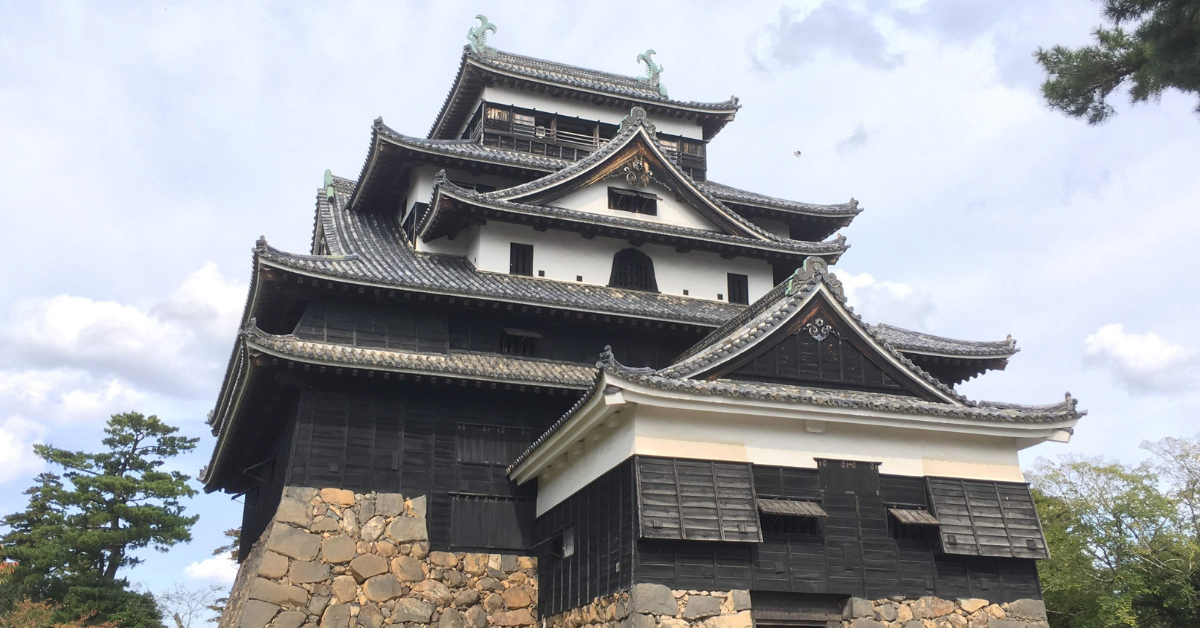Matsue Castle Keep, located in Shimane Prefecture, is one of only 12 surviving original keeps in Japan and among the 5 designated National Treasures. With its black wooden exterior and practical defensive structures, it embodies the castle-building ingenuity of the Sengoku era and the refined aesthetics of samurai culture.
Overview of Matsue Castle Keep
Matsue Castle was completed in 1611 by Horio Yoshiharu. The keep is a five-story, six-level tower with a subdued black wooden exterior. Its nickname, “Chidori Castle” (Plover Castle), comes from the shape of its roof, which resembles a plover spreading its wings.
The keep was not only a symbol of authority but also a practical military structure. It featured loopholes for shooting arrows and guns, as well as “ishiotoshi” (stone-dropping devices) to repel attackers. Built on elevated ground, it commanded a view of the castle town and served as a strategic military base.
Features of Matsue Castle Keep
Matsue Castle has unique characteristics that distinguish it from other castles. Its black exterior, in particular, is rare in Japan and contrasts strikingly with the white appearance of Himeji Castle.
| Feature | Description |
|---|---|
| Architecture | Five-story, six-level, watchtower-style keep |
| Exterior | Black wooden siding, heavy and calm appearance |
| Nickname | Chidori Castle (named after the roof shape) |
| Defense | Loopholes, stone-dropping devices, steep stone walls |
| National Treasure | Designated in 2015 |
Why It Was Designated a National Treasure
Matsue Castle Keep was designated a National Treasure because of its historical importance and excellent state of preservation. Among the 12 surviving keeps in Japan, its defensive features remain intact, making it invaluable for understanding castle construction techniques of the era.
| National Treasure Keeps | Location | Characteristics |
|---|---|---|
| Matsue Castle | Matsue, Shimane | Black exterior, nickname “Chidori Castle” |
| Himeji Castle | Himeji, Hyogo | White Heron Castle, elegant and grand |
| Matsumoto Castle | Matsumoto, Nagano | Crow Castle, black lacquered exterior |
| Inuyama Castle | Inuyama, Aichi | Oldest surviving keep |
| Hikone Castle | Hikone, Shiga | Graceful appearance, excellent preservation |
Views and Experiences from the Keep
Climbing the keep of Matsue Castle offers spectacular views of Lake Shinji and Mount Daisen. At sunset, Lake Shinji becomes especially stunning, known as one of Japan’s 100 best sunset spots. Inside, visitors can see construction materials, weapons, and armor, giving insight into the life of samurai.
Around the castle, the Horikawa sightseeing boat allows visitors to view the keep from the water, offering a perspective different from land. Each season provides its own beauty—cherry blossoms in spring, lush greenery in summer, vivid autumn leaves, and snowy landscapes in winter.
| Season | Highlight |
|---|---|
| Spring | Cherry blossoms around the castle and moat |
| Summer | Green foliage highlighting the black keep |
| Autumn | Brilliant autumn leaves |
| Winter | Snow-covered majestic castle |
Matsue Castle and Castle Town Culture
Matsue Castle was not only a military stronghold but also a cultural and economic hub. The surrounding castle town developed with samurai residences, merchant districts, and artisan quarters.
The tea ceremony culture and wagashi (Japanese sweets) flourished alongside the castle society. Even today, traditional tea houses and long-established sweet shops remain, where visitors can experience Japanese culture.
| Cultural Aspect | Connection to Matsue Castle |
|---|---|
| Tea Ceremony | Spread under the influence of samurai culture, loved by feudal lords |
| Wagashi | Developed uniquely in relation to tea culture |
| Literature | Associated with writer Lafcadio Hearn (Koizumi Yakumo), who lived in Matsue |
Conclusion
Matsue Castle Keep is a National Treasure where history, architecture, and culture come together. Its black, imposing exterior, ingenious defensive features, panoramic views over Lake Shinji, and rich cultural background all combine to leave a deep impression on visitors.
As one of the 12 surviving original keeps and one of the 5 National Treasure keeps, Matsue Castle is an essential site for learning about Japanese castle culture. For international travelers, visiting Matsue Castle is an unforgettable experience and a gateway to understanding Japanese history and tradition.






